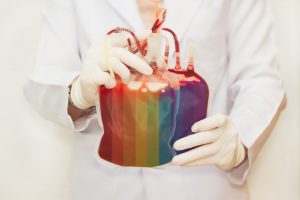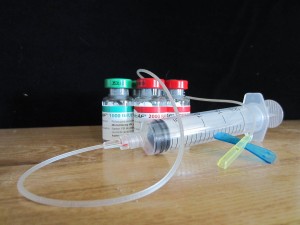About Haemosexual
Background
“Haemophilia” A or B is a rare genetic blood disorder that affects the blood’s ability to clot. When you cut or injure yourself, substances in the blood known as clotting factors combine with blood cells, called platelets, to make the blood sticky. This makes the bleeding stop eventually. However, in haemophilia the clotting factor required, Factor 8 is not produced which inhibits the way blood naturally forms a clot and stops bleeding. This means someone with the condition will bleed for longer than usual and at times can be life threatening.
The symptoms of haemophilia can be mild to severe depending on the level of clotting factors you have. Most cases are classified as severe. People with severe haemophilia often experience internal bleeding. This usually occurs around the joints and muscles, causing extreme pain and stiffness. Over time this can lead to extensive joint damage, requiring surgery, joint replacements and restricting ones ability to lead a “normal” life.
Haemophilia treatment will mainly depend on the severity and for patients with both Haemophilia A or B this involves replacing the clotting factor directly into the bloodstream via intravenous injections. This is done by using blood clotting medications which still includes the use of products manufactured using whole blood components from donors.
There are two methods of treatment regimes used:
On demand – Giving treatment to stop bleeding when perhaps an injury or an episode of prolonged bleeding occurs. This method can sometimes be used to prevent bleeding when certain procedures such as dental extractions are planned. This treatment regime is more commonly used in the management of patients with mild haemophilia.
Preventative treatment (prophylaxis) – Products are used on a regular basis to prevent bleeding episodes, and subsequent complications, such as joint and/or muscle damage. These regimes can differ depending on the severity and dosages required for each infusion. One example would be to infuse a smaller dose normally required to treat an injury, every other day. This regime is the more preferred method used for patients with moderate or severe haemophilia.
History of our struggle for equality
For decades people with disabilities, including the bleeding disorder community have been subjected to offensive behaviour and attitudes, including, intimidation, cruelty and discrimination. Our equal rights have not only been ignored but there appears to be a consistent refusal to listen to us, with an objection to recognising all those requiring support. This has not been exclusive to The UK Haemophilia Society but also includes government officials and health professionals within the NHS. Haemophilia Societies around the world do not have or provide information to people from the LGBT community, living with a bleeding disorder. The United Kingdom can now lead the way in education and supporting all members of the community.
Globally this minority group of people are neglected, breaching the “duty of care” which should be provided to the entire community, regardless of their sexuality.
It is also recognised, fears about sex, sexuality and haemophilia terribly affected information given during the AIDS crisis in the 1980’s. Sadly the stigma and hysteria of the AIDS crisis still influences the manner in which the subject of sexuality is dealt with today.
There are approximately 10,000 men with a bleeding disorder in the UK and based on studies carried out in the general population, (1 in 10) it is estimated that over a thousand could have experience of having sex with men. So far, we have already identified a wide range of different attitudes towards people with bleeding disorders who are gay or bi-sexual here in the UK. We also have a number of examples where people have encountered dangerous situations due to a lack of information or support. Wild assumptions and stereotypical attitudes need to be overcome and looking at those from the LGBT community as people instead of a sexual act or a condition has been almost impossible.
In 2002, The UK Haemophilia Society had received calls from men with bleeding disorders asking for advice on issues concerning men who want to have sex with men. From the feedback, it soon became clear this was not a subject anyone wished to approach. We identified there was no information which could be offered and an attempt was made to bring about change to the institutionalised homophobic attitude of those, both at the Society and those who provide medical care. In some cases patients were told by doctors and nurses “there is no such thing as a gay haemophiliac” or it was “all in your mind, you’ll get over it”. With no information or support available and medical professionals refusing to talk to patients about their sexuality, it was obvious something had to be done.
This prompted the start of the “UK Men’s Project” in 2003, and a supportive booklet was published by the UK Haemophilia Society, entitled “You don’t have to be straight to take Factor 8”. The launch of this ground-breaking project included a presentation to the World Federation of Haemophilia Congress, held in Bangkok, in 2004, attended by Dave Allen and Founder of Haemosexual, Mark Ward.
The booklet was produced by gay men with haemophilia who wanted to share their experience and offer some words of advice, along with answers to some of the questions people may have. A supporting training programme and fact sheet for medical staff was also prepared, in order to give those who did not feel comfortable talking about this subject a point of reference and guidance. Some haemophilia centres refused to display the publication or acknowledge the need for advice on this subject, whilst others embraced it.
However, because of hostile attitudes towards sex and sexuality the project was axed and stopped from developing further as intended.
During the process to elect the next Mayor of London in September 2011, the subject of, “the ban on gay men donating blood” highlighted there was still no information to offer on the subject of blood, blood products, bleeding disorders and sexuality. The need for advice, support and factual guidance appeared to be finally understood.
The decision to take on this project independently was an easy one for Mark Ward to make, now renamed “Haemosexual”.
In February 2014, following major changes at the UK Haemophilia Society, the then CEO, Liz Carroll, welcomed the development of the project and the inclusion of those from the LGBT community.
As the Infected Blood Inquiry continued hearing oral evidence in London. Mark Ward and his partner Richard were the first and only gay couple to take the stand facing questions about their witness statements and the impact it has had on their lives. Mark has become the loan voice in advocating for the LGBT victims not recognised or supported by the British government.
During the annual UK Haemophilia Society AGM 2019, held in Liverpool Mark Ward announced he had become the worlds first LGBT Ambassador for Haemophilia.
To watch & listen to more from Mark Ward please click on the link:
Haemosexual intends to underline the need for better education and understanding of sexual diversity within the global bleeding disorder community. We will be adding our voice and knowledge of the unique issues concerning gay and bi-sexual people with bleeding disorders, which are currently not discussed. No longer will we be out of sight out of mind. We are here and our lives are as important as everyone else with a disability or bleeding disorder.
Backed by those who believe all members of the bleeding disorder community should be treated as equal. We are gaining momentum and are pleased to say the subject of disability, bleeding disorders and the LGBT community is now receiving some recognition. This project has the opportunity to empower, support, educate and grow beyond the boundaries of just a website and the borders of the United Kingdom.
Attitudes towards this part of our community will now have to change. We are taking the subject of sexuality forward sensitively with a more informative, medically sound and preventative approach coupled with compassion and care, to protect people from harm to ensure they feel like a complete person rather than just a bleeding disorder or a condition. A way of life cannot be sterilized to suit ignorance.
We will provide news and updates to ensure people have the opportunity to benefit from shared experiences. Those who wish to become involved in the project can help us reach out to create a global support network.
Exciting times as well as many challenges are ahead of us and we hope the information provided can prevent anyone from feeling as alone, confused and in danger, as we have had to suffer.
Welcome to Haemosexual.

© Haemosexual



